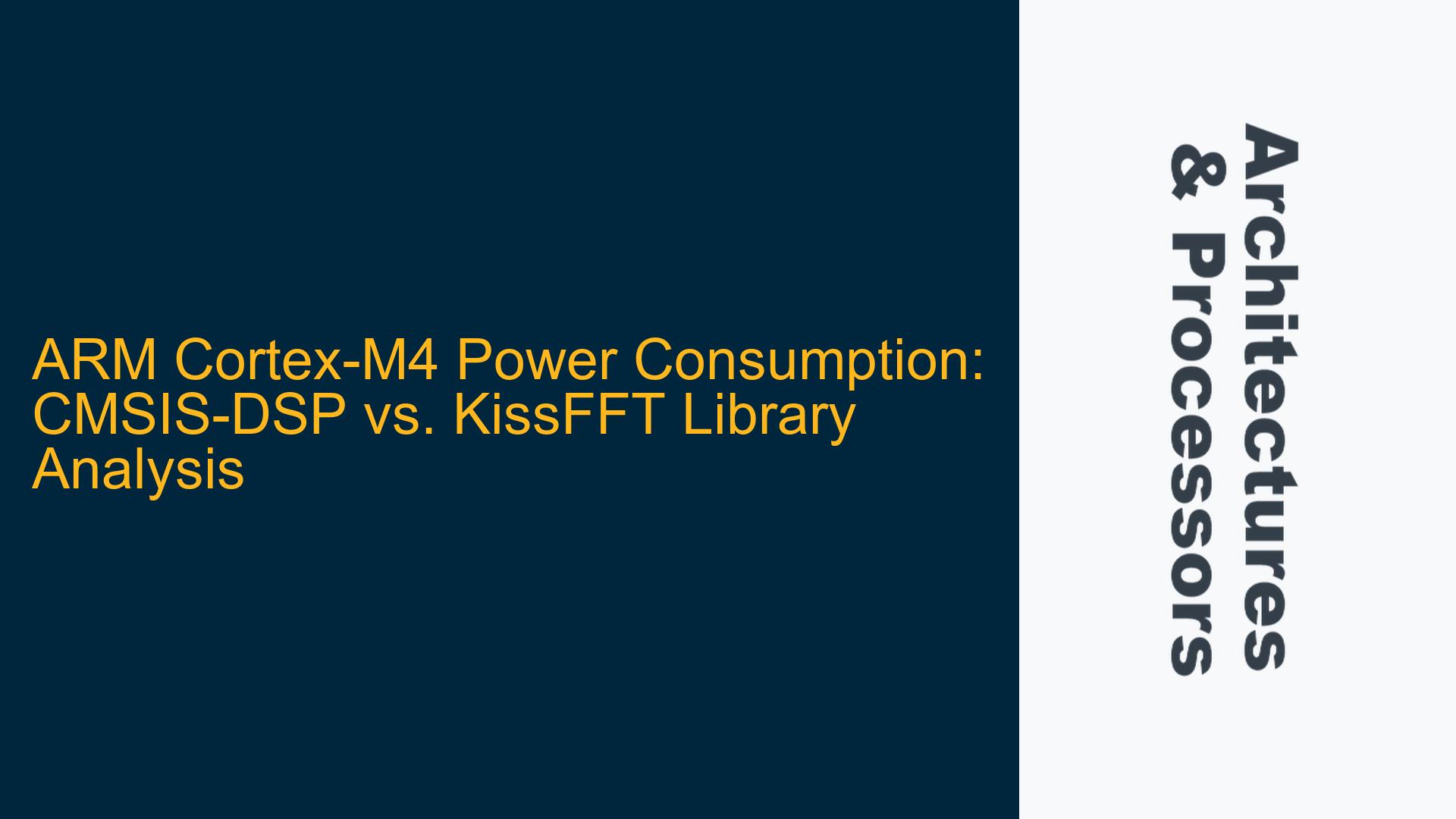ARM Cortex-M4 Power Consumption During DSP Operations
When working with ARM Cortex-M4 microcontrollers, power consumption is a critical consideration, especially in battery-powered or energy-constrained applications. The Cortex-M4, with its DSP extensions and floating-point unit (FPU), is often used for digital signal processing (DSP) tasks such as Fast Fourier Transform (FFT) calculations. Two popular libraries for implementing FFT on Cortex-M4 are the CMSIS-DSP library, provided by ARM, and the KissFFT library, an open-source alternative. While performance benchmarks often focus on execution speed, power consumption is equally important but less frequently discussed.
The Cortex-M4’s power consumption during DSP operations is influenced by several factors, including the efficiency of the library, the utilization of the FPU, the memory access patterns, and the clock frequency. The CMSIS-DSP library is optimized for ARM architectures and leverages the Cortex-M4’s DSP extensions, while KissFFT is a more generic library that may not fully utilize the hardware capabilities of the Cortex-M4. Understanding the power implications of using these libraries requires a detailed analysis of their interaction with the Cortex-M4’s architecture.
CMSIS-DSP and KissFFT Library Power Consumption Factors
The power consumption of the Cortex-M4 when using the CMSIS-DSP or KissFFT library is influenced by several key factors. First, the computational efficiency of the library plays a significant role. The CMSIS-DSP library is highly optimized for the Cortex-M4, utilizing its DSP instructions and FPU to minimize the number of clock cycles required for FFT calculations. This optimization reduces the active time of the CPU, thereby lowering power consumption. In contrast, KissFFT, while portable and flexible, may not fully exploit the Cortex-M4’s hardware capabilities, leading to longer execution times and higher power consumption.
Second, the memory access patterns of the library affect power consumption. The Cortex-M4’s memory subsystem, including its cache and bus architecture, can significantly impact power usage. The CMSIS-DSP library is designed to minimize memory bandwidth usage by optimizing data flow and reducing unnecessary memory accesses. KissFFT, on the other hand, may have less efficient memory access patterns, leading to higher power consumption due to increased memory activity.
Third, the utilization of the FPU is another critical factor. The Cortex-M4’s FPU is a power-hungry component, and its usage must be carefully managed. The CMSIS-DSP library is designed to maximize FPU utilization while minimizing its active time, thereby reducing power consumption. KissFFT, depending on its implementation, may either underutilize the FPU, leading to inefficient power usage, or overutilize it, causing excessive power draw.
Finally, the clock frequency and voltage scaling settings of the Cortex-M4 also play a role in power consumption. Higher clock frequencies generally lead to higher power consumption, but they also reduce the time required to complete tasks. The CMSIS-DSP library’s efficiency allows it to complete tasks faster, potentially enabling lower clock frequencies and reduced power consumption. KissFFT, with its potentially longer execution times, may require higher clock frequencies, leading to increased power usage.
Optimizing Power Consumption for FFT Calculations on Cortex-M4
To optimize power consumption when performing FFT calculations on the Cortex-M4, several steps can be taken. First, it is essential to select the appropriate library based on the specific requirements of the application. For applications where power consumption is a critical concern, the CMSIS-DSP library is generally the better choice due to its optimization for the Cortex-M4 architecture. However, if flexibility and portability are more important, KissFFT may be a viable alternative, albeit with potentially higher power consumption.
Second, the memory access patterns of the application should be carefully optimized. This includes minimizing the number of memory accesses, aligning data structures to reduce cache misses, and using DMA (Direct Memory Access) to offload memory transfers from the CPU. The CMSIS-DSP library’s optimized memory access patterns can serve as a reference for implementing similar optimizations in custom code or other libraries.
Third, the utilization of the FPU should be carefully managed. This includes using the FPU only when necessary, minimizing the number of floating-point operations, and ensuring that the FPU is powered down when not in use. The CMSIS-DSP library’s efficient use of the FPU can serve as a model for implementing similar optimizations in other libraries or custom code.
Fourth, the clock frequency and voltage scaling settings of the Cortex-M4 should be carefully tuned to balance performance and power consumption. This includes using dynamic voltage and frequency scaling (DVFS) to adjust the clock frequency and voltage based on the workload, and using low-power modes when the CPU is idle. The CMSIS-DSP library’s ability to complete tasks quickly can enable lower clock frequencies and reduced power consumption, while KissFFT’s potentially longer execution times may require higher clock frequencies and increased power usage.
Finally, it is essential to measure and analyze the power consumption of the application using a power profiler or similar tool. This includes measuring the power consumption of the Cortex-M4 during different phases of the application, identifying power-hungry components, and implementing optimizations to reduce power consumption. The CMSIS-DSP library’s optimized performance and power efficiency can serve as a benchmark for evaluating the power consumption of other libraries or custom code.
In conclusion, the power consumption of the Cortex-M4 when using the CMSIS-DSP or KissFFT library is influenced by several factors, including the computational efficiency of the library, the memory access patterns, the utilization of the FPU, and the clock frequency and voltage scaling settings. By carefully selecting the appropriate library, optimizing memory access patterns, managing FPU utilization, tuning clock frequency and voltage scaling settings, and measuring and analyzing power consumption, it is possible to optimize the power consumption of FFT calculations on the Cortex-M4. The CMSIS-DSP library, with its optimization for the Cortex-M4 architecture, generally offers better power efficiency compared to KissFFT, making it the preferred choice for power-constrained applications.






